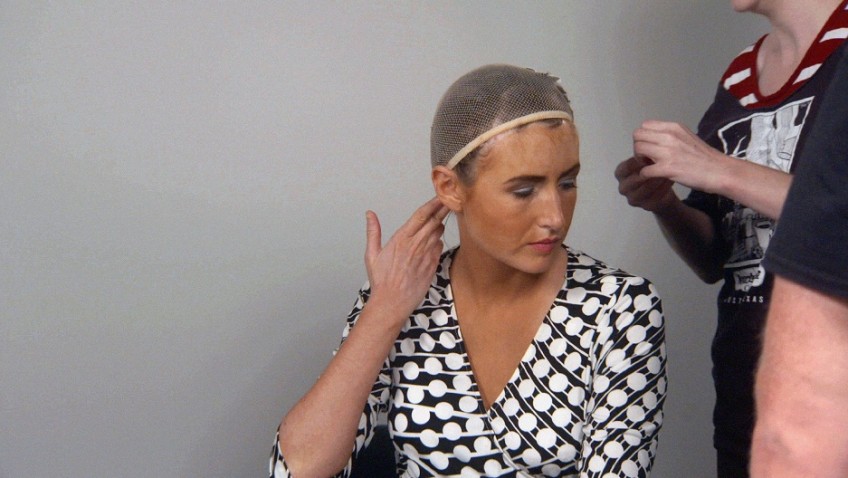Kate Plays Christine (October 14, 2016)
On July 15, 1974 29-year-old television journalist Christine Chubbuck appeared on air as anchorwoman and, after promising viewers a television first, shot herself in the head. Now, 42 years later there are two feature films about Chubbock. Viewers will have to wait to see Rebecca Hall’s chilling performance in Christine, but you can head for the cinema now to see Robert Greene’s pseudo-documentary Kate plays Christine starring Kate Lyn Sheil. Fascinating, probing, and sometimes annoying the film is more successful when it focuses on Christine than on Sheil.
Seldom, however, has a title been more fitting and revealing. For Greene is not only interested in that line between reality and fiction, but in the very nature of recorded performance. After all, Christine Chubbock’s very real suicide was carefully researched, scripted and staged as a message-laden performance. Now it’s the turn of the actress hired to portray her.
In a parallel performance, Sheil the actress prepares for her role in a film about Chubbock and then appears in scripted dramatizations from the movie. It is only some way into the film that you realize that there is no film. This is not ‘The Making of Christine’ – or any other feature film.
Greene films Sheil moving into a Sarasota hotel, buying an unappealing (and not high quality) brown wig, getting a full body tan and changing her eye colour by way of brown contact lenses.
Sheil is bothered, however, by the fact that Christine was a very strong swimmer. As we see when she walks into the Gulf of Mexico, Sheil cannot swim at all. These self-reflective scenes are not as effective as Greene had hoped, however, perhaps because we are more interested in Christine than Sheil.
After trying to find the site of the former station (which was sold in the 1990s) she goes shopping for a gun. ‘They didn’t really do background checks in those days,’ the friendly gun merchant tells Sheil, who knows that Christine had a history of odd behavior that was behind her move from a small town in Ohio to Sarasota when her parents got divorced. ‘Her bedroom was decorated like a 9-year-olds.’
Along the way Sheil tells us about her life as though to draw parallels with Christine although these are strained. Sheil does feel for Christine. ’She had an ovary removed the year before and was told if she ever wanted to have children now is your chance.’ We learn, however that her date with ‘gorgeous George’, a good looking broadcaster at the station, was not the romantic gesture she thought. George had a girlfriend at the station and we meet, and hear from, the actress who plays her. Andrea Kirby was Christine’s only friend in Sarasota but when Christine confided in Andrea that she had a crush on George, Andrea never revealed her existing attachment to him. To a woman with low self-esteem this was a fatal blow.
So here are possible reasons, or combinations of reasons for her unhappiness. Sheil and Greene see Christine’s professional failure as the major factor and this raises issues of feminism and gender politics. ‘It’s men who are making the movie, Sheil points out, so I feel like it’s my responsibility to represent her [Christine]; but they’re trying to do a soap opera.’ This focus on feminism (it was, after all, the 1970s) seems slightly at odds with Christine’s teenage diary where she writes, ‘whatever I become, a housewife, a mother, a good friend, I’ll try to make go of it.
For if there’s anything that leaves a sour taste in my mouth, it’s failure.’ When she set her heart on news casting, she must have seen herself as a failure. Christine had arguments with her boss, Mike-‘if- it-bleeds,-it-leads’ -Simmons about the station’s inclination to air exploitative ‘blood and guts’ stories over her more in-depth reportages about community infrastructure and factors affecting the community.
Sheil’s careful, meticulous preparations for her role do find a parallel with Christine’s preparations for final bid to be heard. Sheil interviews a policeman to learn the best way to shoot oneself in the head, while Christine chose a day when her grandparents would not be watching. Demonstrating that she had turned over a new leaf, she persuaded Simmons to let her anchor the show on July 15th. ‘A perfectionist’, she wrote ‘attempted suicide’ in the script to cover all possible outcomes. This was live TV and there would be no retakes or editing.
Her script certainly was a bitter message to all those who had wronged her. ‘In keeping with Channel 40’s policy of bringing you the latest in blood and guts and in living color, you are going to see another first – an attempted suicide.’
But if Christine hoped to make a public spectacle of her suicide she failed. Not only was there a small audience for the low-ratings’ station, but people quickly forgot about the incident. And worse, as Sheil learns, for the past 40 years the tape of that fateful day has never been shown. Only a few people even knew where it existed (until now). Thanks to a colleague of Christine’s at the station, Sheil is given access to a rare bit of footage of Christine interviewing two people on television. Sheil can finally hear the voice and see Christine’s body language and mannerisms. But it is not the tape.
It is the ending that makes it clear that we are watching a (not very successful) drama passing itself off as an investigative documentary. The plan for the fictitious movie was clearly for Sheil to pull the trigger, but on set, Sheil announces that she can’t go through with it. It is Sheil’s turn to rebel against the ‘if it bleeds, it leads’ school of filmmaking. Is this rebellious moment a show of respect for Christine or because Sheil is too into her character now – or not enough?




